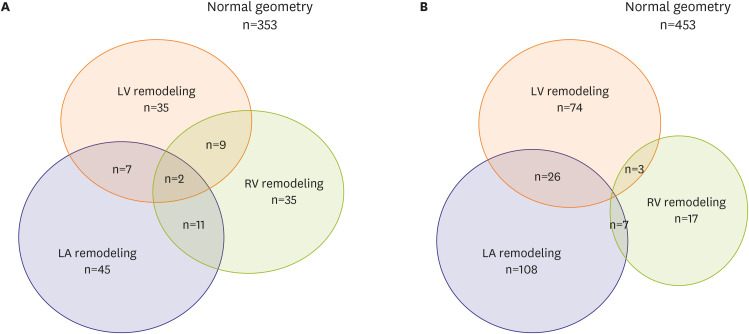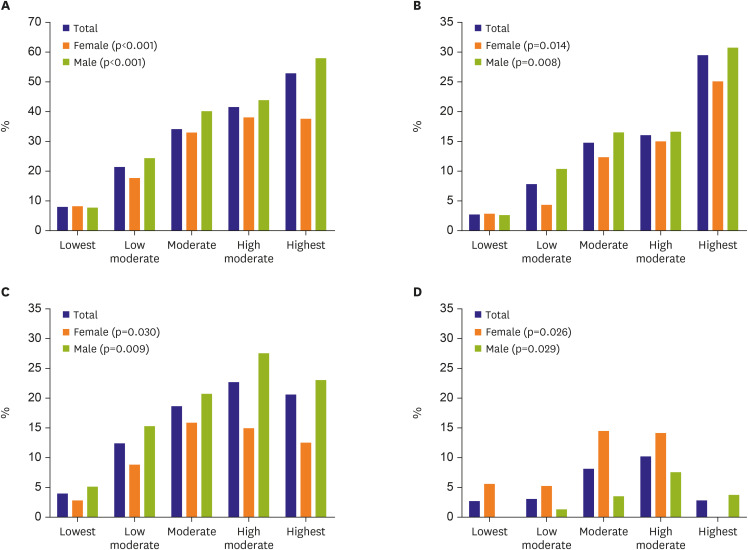Korean Circ J.
2021 May;51(5):426-438. 10.4070/kcj.2020.0484.
Gender Difference of Cardiac Remodeling in University Athletes: Results from 2015 Gwangju Summer Universiade
- Affiliations
-
- 1Department of Cardiology, Chonnam National University Hospital, Chonnam National University Medical School, Gwangju, Korea
- 2International University Sports Federation (FISU), Lausanne, Switzerland
- 3Department of Cardiology in Internal Medicine, Chungnam National University Hospital, Daejeon, Korea
- KMID: 2515766
- DOI: http://doi.org/10.4070/kcj.2020.0484
Abstract
- Background and Objectives
There is little data about cardiac geometry in highly trained young athletes, especially female specific changes. We investigated gender difference on exercise induced cardiac remodeling (EICR) in highly trained university athletes.
Methods
A total of 1,185 university athletes divided into 2 groups; female (n=497, 22.0±2.3 years) vs. male (n=688, 22.6±2.4 years). Remodeling of the left ventricle (LV), left atrium (LA), right ventricle (RV), and any cardiac chamber were compared.
Results
LV, LA, RV, and any remodeling was found in 156 (13.2%), 206 (17.4%), 82 (6.9%), and 379 athletes (31.9%), respectively. LV, LA, and any remodeling were more common in male than female athletes (n=53, 12.1% vs. n=103, 15.5%, p=0.065), (n=65, 13.1% vs. n=141, 20.5%, p<0.001), (n=144, 30.0% vs. n=235, 34.2%, p=0.058), respectively, whereas RV remodeling was significantly more common in female than male athletes (n=56, 11.3% vs. n=26, 3.8%, p<0.001). Interestingly, the development of LV, LA, and RV remodeling were not overlapped in many of athletes, suggesting different mechanism of EICR according to cardiac chamber. Various predictors including sports type, heart rate, muscle mass, fat mass, body surface area, and training time were differently involved in cardiac remodeling, and there were gender differences of these predictors for cardiac remodeling.
Conclusions
EICR was common in both sex and was independently developed among cardiac chambers in highly trained university athletes. LV and LA remodeling were common in males, whereas RV remodeling was significantly more common in females demonstrating gender difference in EICR. The present study also demonstrated gender difference in the predictors of EICR.
Keyword
Figure
Cited by 1 articles
-
Sex Differences in Cardiac Remodeling in Athletes: Men on the Left, Women on the Right?
Chi Young Shim
Korean Circ J. 2021;51(5):439-440. doi: 10.4070/kcj.2021.0021.
Reference
-
1. Pelliccia A, Maron BJ, De Luca R, Di Paolo FM, Spataro A, Culasso F. Remodeling of left ventricular hypertrophy in elite athletes after long-term deconditioning. Circulation. 2002; 105:944–949. PMID: 11864923.
Article2. George KP, Warburton DER, Oxborough D, et al. Upper limits of physiological cardiac adaptation in ultramarathon runners. J Am Coll Cardiol. 2011; 57:754–755. PMID: 21292137.
Article3. Iskandar A, Mujtaba MT, Thompson PD. Left atrium size in elite athletes. JACC Cardiovasc Imaging. 2015; 8:753–762. PMID: 26093921.
Article4. Maron BJ, Maron BA. Revisiting athlete's heart versus pathologic hypertrophy: ARVC and the right ventricle. JACC Cardiovasc Imaging. 2017; 10:394–397. PMID: 27544897.5. Arbab-Zadeh A, Perhonen M, Howden E, et al. Cardiac remodeling in response to 1 year of intensive endurance training. Circulation. 2014; 130:2152–2161. PMID: 25281664.
Article6. Mosca L, Barrett-Connor E, Wenger NK. Sex/gender differences in cardiovascular disease prevention: what a difference a decade makes. Circulation. 2011; 124:2145–2154. PMID: 22064958.7. Regitz-Zagrosek V. Unsettled issues and future directions for research on cardiovascular diseases in women. Korean Circ J. 2018; 48:792–812. PMID: 30146804.
Article8. Pelliccia A, Adami PE. The female side of the heart: sex differences in athlete's heart. JACC Cardiovasc Imaging. 2017; 10:973–975. PMID: 27865720.9. Doronina A, Édes IF, Ujvári A, et al. The female athlete's heart: comparison of cardiac changes induced by different types of exercise training using 3D echocardiography. BioMed Res Int. 2018; 2018:3561962. PMID: 29998132.
Article10. Colombo CSSS, Finocchiaro G. The female athlete's heart: facts and fallacies. Curr Treat Options Cardiovasc Med. 2018; 20:101. PMID: 30390143.
Article11. Galderisi M, Cosyns B, Edvardsen T, et al. Standardization of adult transthoracic echocardiography reporting in agreement with recent chamber quantification, diastolic function, and heart valve disease recommendations: an expert consensus document of the European Association of Cardiovascular Imaging. Eur Heart J Cardiovasc Imaging. 2017; 18:1301–1310. PMID: 29045589.
Article12. Park JH, Kim KH, Rink L, et al. Left atrial enlargement and its association with left atrial strain in university athletes participated in 2015 Gwangju Summer Universiade. Eur Heart J Cardiovasc Imaging. 2020; 21:865–872. PMID: 32380526.
Article13. Rudski LG, Lai WW, Afilalo J, et al. Guidelines for the echocardiographic assessment of the right heart in adults: a report from the American Society of Echocardiography endorsed by the European Association of Echocardiography, a registered branch of the European Society of Cardiology, and the Canadian Society of Echocardiography. J Am Soc Echocardiogr. 2010; 23:685–713. PMID: 20620859.14. Mitchell JH, Haskell W, Snell P, Van Camp SP. Task force 8: classification of sports. J Am Coll Cardiol. 2005; 45:1364–1367. PMID: 15837288.
Article15. Lang RM, Badano LP, Mor-Avi V, et al. Recommendations for cardiac chamber quantification by echocardiography in adults: an update from the American Society of Echocardiography and the European Association of Cardiovascular Imaging. J Am Soc Echocardiogr. 2015; 28:1–39.e14. PMID: 25559473.
Article16. Pathan F, D'Elia N, Nolan MT, Marwick TH, Negishi K. Normal ranges of left atrial strain by speckle-tracking echocardiography: a systematic review and meta-analysis. J Am Soc Echocardiogr. 2017; 30:59–70.e8. PMID: 28341032.
Article17. Finocchiaro G, Sharma S. Do endurance sports affect female hearts differently to male hearts? Future Cardiol. 2016; 12:105–108. PMID: 26916540.
Article18. Cho JY, Kim KH, Rink L, et al. University athletes and changes in cardiac geometry: insight from the 2015 Gwangju Summer Universiade. Eur Heart J Cardiovasc Imaging. 2019; 20:407–416. PMID: 30541113.
Article19. Marcus FI, McKenna WJ, Sherrill D, et al. Diagnosis of arrhythmogenic right ventricular cardiomyopathy/dysplasia: proposed modification of the task force criteria. Circulation. 2010; 121:1533–1541. PMID: 20172911.20. D'Ascenzi F, Pisicchio C, Caselli S, Di Paolo FM, Spataro A, Pelliccia A. RV remodeling in Olympic athletes. JACC Cardiovasc Imaging. 2017; 10:385–393. PMID: 27544901.21. Pelliccia A, Maron BJ, Culasso F, Spataro A, Caselli G. Athlete's heart in women. Echocardiographic characterization of highly trained elite female athletes. JAMA. 1996; 276:211–215. PMID: 8667565.
Article22. Zaidi A, Ghani S, Sharma R, et al. Physiological right ventricular adaptation in elite athletes of African and Afro-Caribbean origin. Circulation. 2013; 127:1783–1792. PMID: 23538381.
Article23. D'Ascenzi F, Pelliccia A, Solari M, et al. Normative reference values of right heart in competitive athletes: a systematic review and meta-analysis. J Am Soc Echocardiogr. 2017; 30:845–858.e2. PMID: 28865556.24. D'Andrea A, Morello A, Iacono AM, et al. Right ventricular changes in highly trained athletes: between physiology and pathophysiology. J Cardiovasc Echogr. 2015; 25:97–102. PMID: 28465945.25. Douglas PS, O'Toole ML, Hiller WD, Reichek N. Different effects of prolonged exercise on the right and left ventricles. J Am Coll Cardiol. 1990; 15:64–69. PMID: 2295743.
Article26. Foryst-Ludwig A, Kintscher U. Sex differences in exercise-induced cardiac hypertrophy. Pflugers Arch. 2013; 465:731–737. PMID: 23417601.
Article27. Mittendorfer B, Horowitz JF, Klein S. Effect of gender on lipid kinetics during endurance exercise of moderate intensity in untrained subjects. Am J Physiol Endocrinol Metab. 2002; 283:E58–65. PMID: 12067843.
- Full Text Links
- Actions
-
Cited
- CITED
-
- Close
- Share
- Similar articles
-
- The Analysis of Medical Services during Summer Universiade
- Sex Differences in Cardiac Remodeling in Athletes: Men on the Left, Women on the Right?
- Injuries and Illnesses of Korean Athletes during the Almaty Winter Universiade Games 2017
- Do Young Athletes Need Vitamin D Supplement? Vitamin D Status and Deficiency Related Factor on Sports Type (Indoor vs. Outdoor), Age, Sex, Body Mass Index, Seasonal Variations in Korean Young Athletes
- Influences on Biochemical Parameters or Cardiac Structure and Function of Serum Total Homocysteine Concentration in Athletes



